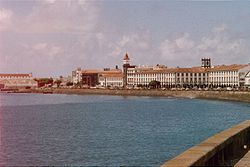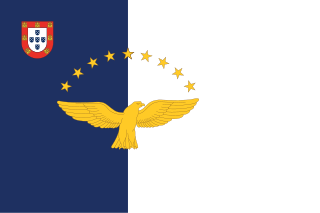
The Azores, officially the Autonomous Region of the Azores, is one of the two autonomous regions of Portugal. It is an archipelago composed of nine volcanic islands in the Macaronesia region of the North Atlantic Ocean, about 1,400 km (870 mi) west of Lisbon, about 1,500 km (930 mi) northwest of Morocco, and about 1,930 km (1,200 mi) southeast of Newfoundland, Canada.
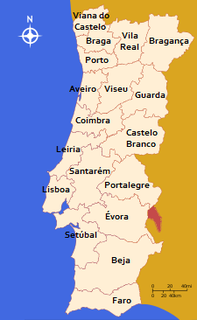
The Districts of Portugal, are the most important first-level administrative subdivisions of continental Portugal. Currently, mainland Portugal is divided into 18 districts. The Portuguese Autonomous Regions of Açores and Madeira are no longer divided into districts.
There are 22 district Football Associations in Portugal. These organizations are the governing bodies of football in each Portuguese district.

Postage stamps and postal history of the Azores surveys the postal history of the Portuguese archipelago, situated in the north Atlantic.

Angra do Heroísmo, or simply Angra, is a city and municipality on Terceira Island, Portugal, and one of the three capital cities of the Azores. Founded in 1478, Angra was historically the most important city in the Azores, as seat of the Bishop of the Azores, government entities, and having previously served as the capital city of Portugal during the Liberal Wars. The population in 2011 was 35,402, in an area of 239.00 km². It was classified as a World Heritage site by UNESCO in 1983.

Vila do Corvo is the smallest municipality in the Portuguese archipelago of the Azores, constituting the island of Corvo in its entirety. With a population of 430 in 2011, it is the least populated of the Portuguese municipalities, and the only Portuguese municipality, by law, without a civil parish. Its area is 17.11 square kilometres (6.61 sq mi).

Santa Cruz das Flores is a municipality situated in the north half of the island of Flores, in the Portuguese archipelago of the Azores. Situated in the sparsely populated Western Group, the population in 2011 was 2,289 inhabitants in an area that covers approximately 70.91 square kilometres (27.38 sq mi), bordering the southern municipality of Lajes das Flores.

The University of the Azores, or commonly abbreviated as UAc, is the only public university in the Autonomous Region of the Azores. It was founded on January 9, 1976, two years after the Carnation Revolution that ended several decades of dictatorship in Portugal, but before the Portuguese Third Republic was institutionalized, along with the Region's Autonomy. The university is a public institution dependent on the Ministry of Science, Technology and Higher Education and was established in order to advance sustainable development and higher education in the Azores.
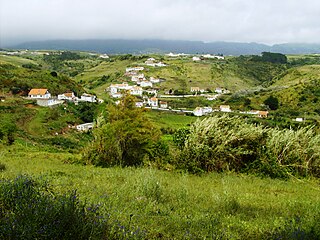
Vila do Porto is a civil parish in the municipality of Vila do Porto, located on the island of Santa Maria, in the Portuguese autonomous region of Azores. It is the southernmost and easternmost parish in the archipelago of Azores. The population in 2011 was 3,119, in an area of 25.55 km².
The Historical Institute of Terceira, or literally the Historical Institute of the Island of Terceira, or IHIT, is a private association and cultural institute, dedicated to the investigation and studying of the islands of the Azores. The institute is headquartered in the classical Convent of São Francisco in Angra do Heroísmo.
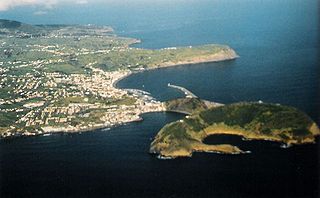
The District of Horta was a district of the Ilhas Adjacentes, consisting of the dependent western islands of the Azores, located in the Atlantic Ocean. The district of Horta, not to be confused with the modern municipality of Horta, existed from 1836 until 1976 when it was abolished in favour of the autonomy charter of the 1975 Portuguese Constitution.

Ponta Delgada is the largest municipality (concelho) and economic capital of the Autonomous Region of the Azores in Portugal. It is located on São Miguel Island, the largest and most populous in the archipelago. As of 2021, it has 67,287 inhabitants, in an area of 232.99 square kilometres. There are 17,629 residents in the three central civil parishes that comprise the historical city: São Pedro, São Sebastião, and São José. Ponta Delgada became the region's administrative capital under the revised constitution of 1976; the judiciary and Catholic See remained in the historical capital of Angra do Heroísmo while the Legislative Assembly of the Azores was established in Horta.

The political status of the Azores is defined by the Political-Administrative Statute of the Autonomous Region of the Azores, which acts as the standard legal constitutional framework for the autonomy of the Portuguese archipelago of the Azores. It defines the scope of the autonomous regional government and the structure and functioning of the region's organs of government within the framework of the 1976 Constitution of Portugal. The autonomous region of Madeira has a similar status.
Azores Day is a regional holiday in the Portuguese archipelago of the Azores. It commemorates the establishment of Azorean political autonomy in the Portuguese Constitution, following the Carnation Revolution. The date corresponds to the Festival of the Holy Spirit, a celebration based in the archipelago's religious and cultural history, held on the Sunday of Pentecosts, a movable public holiday observed only in the archipelago of the Azores.
A Captaincy-General of the Azores (1766—1832) was a politico-administrative structure of governance imposed in the Azores on 2 August 1766, with its seat in Angra. It remained the de facto system of governance for 65 years, until it was abolished on 4 June 1832 by D. Peter IV, but by 1828 its de jure status had made it nonoperational, owing to the revolutionary movements that lead to the Liberal Wars. The creation of the Captaincy-General was part of the Pombaline reforms to the Portuguese administration, during the reign of Joseph I, under the initiatives of Sebastião José de Carvalho e Melo, 1st Marquis of Pombal, then prime minister. A Captaincy-General operated from the Palace of the Captains-General, under the direction of the titular Captain-General, who operated as the Governor of the Azores, with additional jurisdiction on every island of the Azorean archipelago. The Captaincy-General was succeeded by the Province of the Azores, an ephemeral administrative structure that was collapse in the immediate years.

The Windmills of Corvo is a group of windmills located in the municipality of Vila do Corvo, island of Corvo, in the Portuguese archipelago of the Azores.
The Regional Junta of the Azores was the governing body created under Decree-Law 458-B/75, to substitute the Civil Governors of the autonomous districts of Ponta Delgada, Angra do Heroísmo and Horta and their individual General Juntas. The Regional Junta was initially proposed by the Group of 11 (Portuguese: Grupo dos Onze, presided by the Civil Governor of the autonomous district of Ponta Delgada, António Borges Coutinho, in January 1975. Ironically, its creation was attributed to the events on 6 June 1975. The Regional Junta of the Azores governed for little more than a year, between 22 August 1975 and 8 September 1976.
The District of Angra do Heroísmo, was a district of the Ilhas Adjacentes, consisting of the dependent central islands of the Azores. The district of Angra, not to be confused with the modern municipality of Angra do Heroísmo, existed until 1976 when it was abolished in the favor of the autonomy charter of the 1976 Portuguese Constitution.

Aires Pinto de Sousa Coutinho was a noble, colonial administrator, 6th Captain-General of the Azores, Field Marshal and master of the House of Balsemão and Ferreiros de Tendais.
